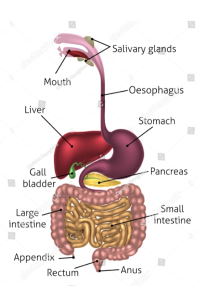CONDITIONS
What is Digestive System?
The digestive system consists of two main components: the gastrointestinal (GI) tract and the solid organs, including the liver, pancreas, and gallbladder. The GI tract is a long hollow tube extending from the mouth to the anus that consists of various hollow organs such as the mouth, esophagus, stomach, small intestine, large intestine, and anus.
The small intestine has three sections: the duodenum, jejunum, and ileum. The large intestine includes the appendix, cecum, colon, and rectum. The appendix is a small pouch shaped like a finger connected to the cecum. The colon is divided into several parts. The initial section is the cecum. The remaining segments include the ascending colon (upward direction), transverse colon (crossing to the left), descending colon (downward direction), and sigmoid colon (curving back to the right). The rectum is the last part of the large intestine.
The digestive system helps us break down and absorb nutrients from our food. These nutrients are essential for providing energy, supporting growth, and repairing our body’s cells.
Digestion Process
Mouth: Food enters the digestive system through the mouth. When we chew our food, it is broken down into smaller pieces, making it easier for digestion. At the same time, saliva mixes with the food, breaking it down into a form that our body can absorb and utilize. After chewing, when you swallow, your tongue moves the food into your throat and the esophagus.
Esophagus: The esophagus is a muscular tube that connects the mouth to the stomach. During swallowing, the epiglottis, a small flap, folds over your windpipe to prevent choking by ensuring that food does not enter the windpipe. Through a series of muscular contractions known as peristalsis, the esophagus transports food from the throat to the stomach.
Stomach: The stomach is a sac-like organ that receives food from the esophagus. It stores and mixes the food with digestive juices, including stomach acid and enzymes, to break down the food.
Small Intestine: The small intestine has three parts: the duodenum, jejunum, and ileum. The duodenum receives partially digested food from the stomach, digestive enzymes from the pancreas, and bile from the liver and gallbladder. It further breaks down the food. The jejunum and ileum are crucial in absorbing nutrients from the digested food and transferring them into the bloodstream.
Large Intestine: The large intestine, also known as the colon, absorbs water and electrolytes from the remaining indigestible food matter. It also houses beneficial bacteria that aid in digestion and produces certain vitamins.
Rectum and Anus: The rectum is the part where feces are stored until they are eliminated through the anus during a bowel movement.
Three accessory organs are involved in digestion, including:
Liver: The liver produces bile, which is stored in the gallbladder and helps digest and absorb fats.
Pancreas: The pancreas produces digestive enzymes that are released into the small intestine to break down carbohydrates, proteins, and fats.
Gallbladder: The gallbladder stores and concentrates bile produced by the liver and releases it into the small intestine to aid in the digestion of fats.









